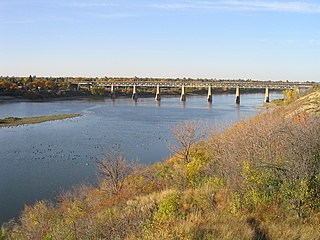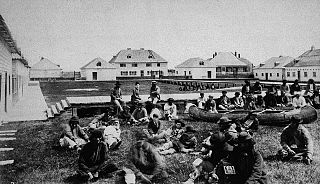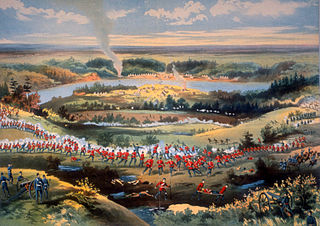
The Saulteaux are a First Nations band government in Ontario, Manitoba, Saskatchewan, Alberta and British Columbia, Canada. They are a branch of the Ojibwe when they pushed west forming into a mixed culture of woodlands and plains Indians customs and traditions.

The Saskatchewan River is a major river in Canada, about 550 kilometres (340 mi) long, flowing roughly eastward across Saskatchewan and Manitoba to empty into Lake Winnipeg. Through its tributaries the North Saskatchewan and South Saskatchewan, its watershed encompasses much of the prairie regions of central Canada, stretching westward to the Rocky Mountains in Alberta and northwestern Montana in the United States. It reaches 1,939 kilometres (1,205 mi) to its farthest headwaters on the Bow River, a tributary of the South Saskatchewan in Alberta.

Fort Severn First Nation is a Cree First Nation band government located on Hudson Bay and is the most northern community in Ontario, Canada. In 2001, the population was 401, consisting of 90 families in an area of 40 square kilometres. The legal name of the reserve is Fort Severn 89, with the main settlement of Fort Severn.

The Assiniboine or Assiniboin people, also known as the Hohe and known by the endonym Nakota, are a First Nations/Native American people originally from the Northern Great Plains of North America.
First Nations in Alberta are Indigenous peoples who live in the Canadian province of Alberta. The First Nations are peoples recognized as Aboriginal peoples in Canada excluding the Inuit and the Métis. According to the 2011 Census, a population of 116,670 Albertans self-identified as First Nations. Specifically there were 96,730 First Nations people with registered Indian Status and 19,945 First Nations people without registered Indian Status. Alberta has the third largest First Nations population among the provinces and territories. From this total population, 47.3% of the population lives on an Indian reserve and the other 52.7% live in urban centres. According to the 2011 Census, the First Nations population in Edmonton totalled at 31,780, which is the second highest for any city in Canada. The First Nations population in Calgary, in reference to the 2011 Census, totalled at 17,040. There are 48 First Nations or "bands" in Alberta, belonging to nine different ethnic groups or "tribes" based on their ancestral languages.
First Nations in Saskatchewan constitute many Native Canadian band governments. First Nations ethnicities in the province include the Cree, Assiniboine, Saulteaux, Dene and Dakota. Historically, the Atsina and Blackfoot could also be found at various times.

Cumberland House is a community in Census Division No. 18 in northeast Saskatchewan, Canada on the Saskatchewan River. It is the oldest settler community in Saskatchewan and has a population of about 2,000 people. Cumberland House Provincial Park, which provides tours of an 1890s powder house built by the Hudson's Bay Company, is located nearby.

Norway House is a population centre of over 5,000 people some 30 km (19 mi) north of Lake Winnipeg, on the bank of the eastern channel of Nelson River, in the province of Manitoba, Canada. The population centre shares the name Norway House with the northern community of Norway House and Norway House 17, a First Nation reserve of the Norway House Cree Nation. Thus, Norway House has both a Chief and a Mayor.

Fort Paskoya or Paskoyac or Pasquia was a French fort and trading post on the lower Saskatchewan River above Cedar Lake (Manitoba). Around 1740 La Vérendrye built four forts to control the chain of lakes west of Lake Winnipeg. These were Fort Pascoya, Fort Bourbon, Fort Dauphin (Manitoba) and Fort La Reine. Their purpose was to trade in furs and to divert to Montreal furs that had previously gone to the English on Hudson Bay. Pascoya had a good location because most of the furs from the west and northwest came down the Saskatchewan. The forts were also part of a quest for a river that led to the western sea, which Verendrye now thought was the Saskatchewan.

Treaty 4 is a treaty established between Queen Victoria and the Cree and Saulteaux First Nation band governments. The area covered by Treaty 4 represents most of current day southern Saskatchewan, plus small portions of what are today western Manitoba and southeastern Alberta. This treaty is also called the "Qu'Appelle Treaty," as its first signings were conducted at Fort Qu'Appelle, North-West Territories, on 15 September 1874. Additional signings or adhesions continued until September 1877. This treaty is the only indigenous treaty in Canada that has a corresponding indigenous interpretation.

Division No. 15 is one of eighteen census divisions in the province of Saskatchewan, Canada, as defined by Statistics Canada. It is located in the north-central part of the province. The most populous community in this division is Prince Albert.
The Lac La Ronge Indian Band is the largest Cree First Nation band government in La Ronge, Saskatchewan, and one of the 10 largest in Canada, with a 2016 population of 10,408. Its location is in north-central Saskatchewan. They are a Woodland Cree First Nation.

Kinistino No. 459 is a rural municipality in the Canadian province of Saskatchewan, located in the Census Division 15. The seat of the municipality is located in the Town of Kinistino.

The Mathias Colomb First Nation, Mathias Colomb Cree Nation (MCCN), Mathias Colomb (Cree) First Nation, Pukatawagan/Mathias Colomb Cree Nation is a remote northern Manitoba First Nations, located 210 km (130 mi) north of The Pas and 819 km (509 mi) northwest of Winnipeg, Manitoba, which had two reserves under its jurisdiction, Indian Rreserve (IR) 198 and IR No. 199. They are part of the Treaty 6 and the main community is at Pukatawagan and consists of 1,536.6 ha on the shore of Pukatawagan Lake and lies about 210 km (130 mi) north of The Pas. Their second reserve was the Highrock reserve (CSD) located on Highrock Lake, 30 km (19 mi) downstream from Pukatawagan, which was dissolved by 2006.
Treaty Four Reserve Grounds Indian Reserve No. 77 is an Indian Reserve in Saskatchewan, Canada, shared by 33 band governments from Saskatchewan and Manitoba. The Reserve Grounds are located adjacent to and west of Fort Qu'Appelle, Saskatchewan. All bands are signatories to Treaty 4. This Reserve may belong to Assiniboine Chief Long Lodge #77. Who was a treaty signatory chief to treaty 4 in 1877 at Cypress Hills
Saddle Lake Cree Nation is an Amiskwacīwiyiniwak division of the Plains Cree, historically speaking the Plains Cree language and located in central Alberta. The Nation is a signatory to Treaty 6. This First Nation's governing structure is unusual in that it has two separate councils and chiefs governing different Indian reserves, one called the Saddle Lake Cree Nation (proper) and the other called the Whitefish Lake First Nation, often called "Whitefish (Goodfish) Lake First Nation" to distinguish it from a similarly named group in Manitoba. For the purposes of the Indian Act however the Saddle Lake and Whitefish are one band government.














